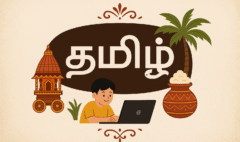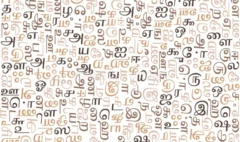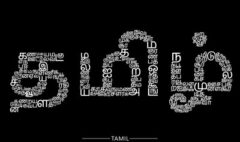The Role of Tamil in Indian Cinema Beyond Kollywood
The Role of Tamil in Indian Cinema Beyond Kollywood
Beyond Borders: Tracing the Influence of the Tamil Language in Indian Cinema Beyond Kollywood
When we think of the Tamil language in cinema, our minds immediately go to Kollywood, the vibrant and prolific film industry based in Chennai. For over a century, Kollywood has been the primary crucible in which the cinematic language of Tamil has been forged, celebrated, and exported to a global audience. However, the influence and presence of the Tamil language in Indian cinema is not confined to the borders of its own industry. In the increasingly interconnected and collaborative world of modern Indian filmmaking, the sounds, stories, and stars of Tamil cinema are having a significant and growing impact on other regional industries and on the very idea of a “pan-Indian” film. The role of Tamil in other Indian films is a fascinating story of linguistic crossover, creative collaboration, and cultural exchange. From the dubbed versions of blockbuster hits to the subtle integration of its vocabulary and narrative styles, the Tamil language influence is a testament to the power and appeal of its cinematic tradition. This guide will explore the various ways in which Tamil is making its mark beyond Kollywood, shaping the landscape of pan-Indian cinema and enriching the tapestry of regional cinema as a whole.
The Dubbing Revolution: How Tamil Stories Conquered the Nation
The most direct and powerful way that Tamil has expanded its cinematic reach is through the practice of dubbing. For decades, films were largely confined to their own linguistic regions. However, with the advent of satellite television in the 1990s and, more recently, the explosion of streaming platforms (OTT), the walls between regional industries have crumbled. This has allowed high-concept, high-quality Tamil films to find a massive new audience across India.
- The South Indian Dubbing Wave: For many years, audiences in the Hindi-speaking heartland were introduced to Tamil cinema through dubbed versions of action films and masala entertainers that were broadcast on television channels. Superstars like Rajinikanth and Kamal Haasan became household names across the country, their powerful dialogues and charismatic screen presence transcending the language barrier through the work of talented dubbing artists.
- The Pan-Indian Phenomenon: The game-changer was the “pan-Indian” film model, perfected by the Telugu film “Baahubali.” The strategy involves producing a film with a universally appealing story and releasing it simultaneously in multiple languages (including Tamil, Telugu, Hindi, Malayalam, and Kannada). Major Tamil productions have successfully adopted this model. Mani Ratnam’s epic “Ponniyin Selvan,” Shankar’s sci-fi extravaganza “2.0” starring Rajinikanth, and Lokesh Kanagaraj’s action-thriller “Vikram” were all released with high-quality dubbed versions across India, becoming massive commercial successes. This has meant that the stories, themes, and cultural sensibilities of Tamil cinema are now a part of the national cinematic conversation.
This dubbing revolution means that millions of non-Tamil speakers are now familiar with the narrative beats, the musical styles, and the star power of Kollywood, creating a shared cinematic culture.
Linguistic Crossovers: The “Tanglish” Effect and Borrowed Vocabulary
The influence is not just a one-way street of dubbing. The language of Tamil cinema has begun to seep into the lexicon of other industries.
- The Spread of “Tanglish”: The fluid and creative blend of Tamil and English, known as “Tanglish,” which is a hallmark of modern urban Tamil films, has influenced the way characters speak in other regional cinemas as well. The casual, code-switching style reflects the reality of modern, multilingual India, and Tamil cinema has been a pioneer in capturing this linguistic trend.
* Borrowed Slang and Exclamations: Certain Tamil words and expressions have become so iconic through cinema that they are now understood and even used by non-Tamil speakers. The classic exclamation “Aiyo!” is a pan-South Indian staple. The slang word “Macha” (dude/bro) is widely recognized. When a character in a Hindi or Telugu film uses one of these words, they are tapping into a shared cultural shorthand that has been popularized by Tamil films.
* Musical Influence: The lyrics of Tamil songs, especially those by iconic composers like Ilaiyaraaja and A.R. Rahman, have had a massive influence. A.R. Rahman, in particular, often composes his songs simultaneously in Tamil and Hindi, and the lyrical themes and poetic sensibilities of the Tamil original often carry over into the other versions.
The Two-Way Street: Tamil Characters and Settings in Other Cinemas
As Indian cinema becomes more interested in telling diverse and authentic regional stories, we are seeing a growing number of films from other industries that are set in Tamil Nadu or feature prominent Tamil characters.
- Bollywood’s Southern Gaze: The Hindi film industry (Bollywood) has produced several popular films that are set in Tamil Nadu and feature Tamil characters. Films like “Chennai Express” and “2 States” are prominent examples. While these portrayals can sometimes rely on stereotypes, they have also introduced a massive national audience to the sights, sounds, and cultural quirks of Tamil Nadu. These films invariably feature a mix of Hindi and Tamil, with characters using basic Tamil greetings and phrases, further familiarizing the national audience with the language.
* Authenticity in Regional Cinema: The Malayalam film industry, in particular, has a strong tradition of producing films set in the border regions between Kerala and Tamil Nadu. These films often feature a naturalistic and bilingual dialogue, with characters switching between Malayalam and the specific dialect of Tamil spoken in that region. This provides a wonderfully authentic glimpse into the linguistic realities of these cross-cultural spaces.
Creative Collaboration: The Blurring of Industry Lines
The modern Indian film industry is less a collection of isolated silos and more an interconnected network of talent. This creative collaboration ensures that the influence of the Tamil language and its artists is constantly felt across the country.
- Pan-Indian Stars: Actors who started their careers in Tamil cinema, like Dhanush and Vijay Sethupathi, are now major stars in Hindi films as well, bringing their unique acting styles and cultural context to a national audience.
- Technicians and Directors: Many of the most sought-after directors, cinematographers, and music composers in India hail from the Tamil film industry. When a director like Mani Ratnam or Shankar makes a film, even if it is in Hindi, they bring with them a distinctly Tamil aesthetic and storytelling sensibility. A.R. Rahman’s music, which is deeply rooted in the Tamil musical tradition, has become the soundtrack for all of India.
Conclusion: A Powerful Voice in a National Chorus
The role of the Tamil language in Indian cinema is no longer confined to the boundaries of Kollywood. Through the powerful mechanisms of dubbing and the rise of the pan-Indian film, the stories and sounds of Tamil cinema have become an integral part of the national cinematic experience. The subtle but significant influence of its vocabulary, its narrative styles, and its immense creative talent can be felt across every major film industry in the country. For the language learner, this is a wonderful and exciting development. It means that the resources for your immersion are vaster than ever before. You can watch a blockbuster Hindi film and delight in the surprise of hearing a Tamil phrase, or you can watch the dubbed version of a Tamil masterpiece and know that you are participating in a shared, nationwide cultural conversation. The powerful, creative, and resilient voice of the Tamil language is no longer just a regional one; it is a vital and influential voice in the grand, multilingual chorus of Indian cinema.









